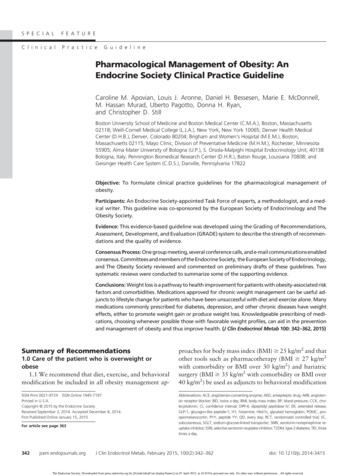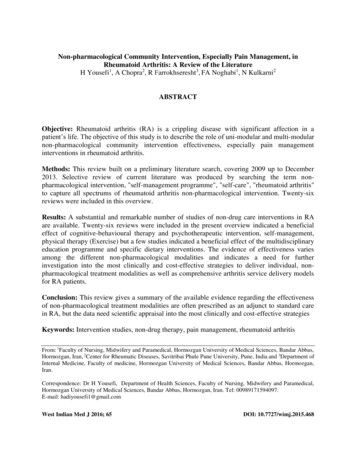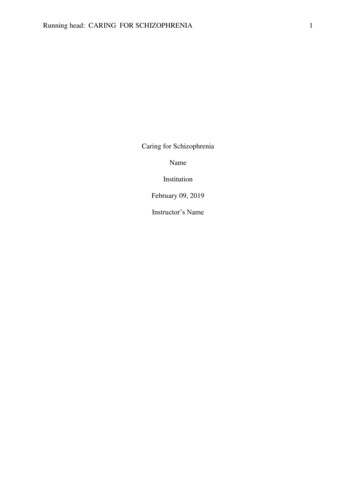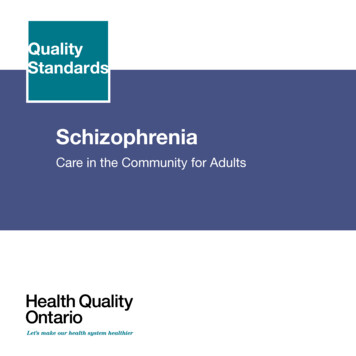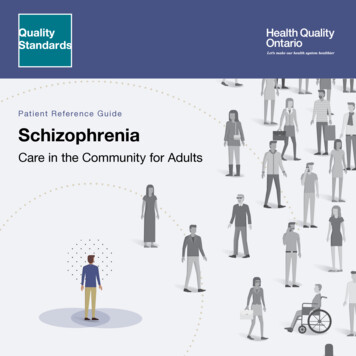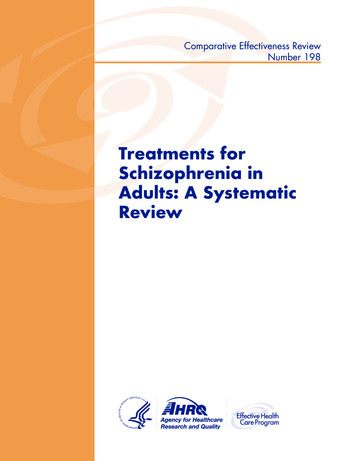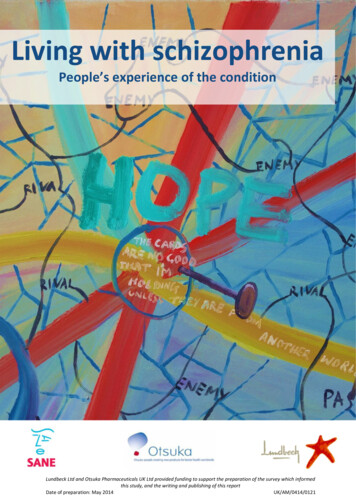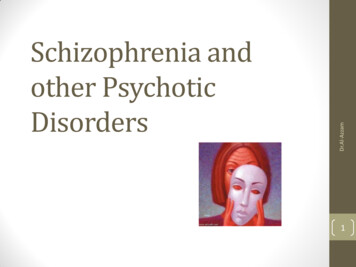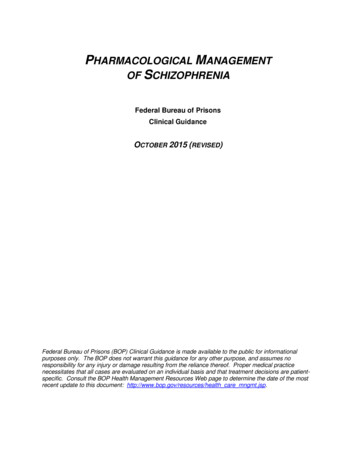
Transcription
PHARMACOLOGICAL MANAGEMENTOF SCHIZOPHRENIAFederal Bureau of PrisonsClinical GuidanceOCTOBER 2015 (REVISED)Federal Bureau of Prisons (BOP) Clinical Guidance is made available to the public for informationalpurposes only. The BOP does not warrant this guidance for any other purpose, and assumes noresponsibility for any injury or damage resulting from the reliance thereof. Proper medical practicenecessitates that all cases are evaluated on an individual basis and that treatment decisions are patientspecific. Consult the BOP Health Management Resources Web page to determine the date of the mostrecent update to this document: http://www.bop.gov/resources/health care mngmt.jsp.
Federal Bureau of PrisonsClinical GuidancePharmacological Management of SchizophreniaOctober 2015 (revised)WHAT’S NEW IN THIS DOCUMENT?This revised BOP Clinical Guidance on the Pharmacological Management of Schizophreniacontains the following revisions to the October 2015 BOP Clinical Practice Guidelines (CPG): The Diagnostic and Statistical Manual of Mental Disorders (DSM-5) is now copyrighted. The Appendix containing a summary of DSM-5 criteria for schizophrenia has therefore beendeleted. The Abnormal Involuntary Movement Scale (AIMS) is now Appendix 15. Readers are referred to the actual DSM-5 text for specific diagnostic criteria. The October 2015 CPG underwent a pharmaceutical review in October 2016. As a result, changeswere made to Appendix 6, Antipsychotic Dosing Charts, as follows: The starting dose for haloperidol D is now 25–100 mg IM every 2 weeks. In addition, a note has been added to advise establishing tolerance to oral fluphenazine or oralhaloperidol prior to changing to an IM decanoate injection.The October 2015 guidelines contained the following revisions to the 2010 BOP Clinical PracticeGuidelines for the Medical Management of Schizophrenia: The title was changed to Pharmacological Management of Schizophrenia since the guidelines addressonly the pharmacologic intervention for inmates with schizophrenia. While pharmacologic managementis among the well-established treatments for schizophrenia, other modes—as outlined in the ProgramStatement 5310.13 (Treatment and Care of the Inmate with Mental Illness)—must also be addressed intreating schizophrenia. The total treatment approach involves medical and psychology personnelworking together. Changes were made to Section 5, Antipsychotic Medication: The term third-generation antipsychotics (TGAs) is no longer in use. Aripiprazole is nowconsidered a second-generation antipsychotic (SGA). In addition to the Clinical Antipsychotic Trials of Intervention Effectiveness (CATIE) study, results ofseveral other studies comparing the efficacy of different antipsychotics are noted. Overall, in termsof relative efficacy, SGAs have no predictable advantage over first-generation antipsychotics(FGAs), and both classes of drugs seem to be similarly efficacious. See Studies of the RelativeEffectiveness of Antipsychotics in Section 5. Changes were made to Section 6, Adjunctive Medications. The section on selecting an antidepressant was expanded to include selective serotonin reuptakeinhibitors (SSRIs) more broadly. Changes were made to the following Appendices: Appendix 1, Antipsychotic Treatment Algorithm was revised. The current algorithm is adaptedfrom one developed by the Veterans Affairs Pharmacy Benefits Management Services in June2012. This algorithm applies only to schizophrenia and schizoaffective disorders, and is notapplicable to other conditions where an antipsychotic is indicated, such as monotherapy oradjunctive therapy for bipolar disorder (manic, mixed, or depressed) or unipolar depressed with orwithout psychosis. Second-generation psychotic indications for these disorders are alsocontinuously evolving. Appendix 3, Antipsychotic Medications was updated to list only FGAs and SGAs, and now includesseveral new SGAs. The statement concerning formulary status was expanded. Appendix 4a, Side Effects of First-Generation Antipsychotics was updated. It now contains a“black box” warning that antipsychotics are not approved for dementia-related psychosis. Appendix 4b, Side Effects of Second-Generation Antipsychotics was updated so that it no longerrefers to TGAs.i
Federal Bureau of PrisonsClinical Guidance Pharmacological Management of SchizophreniaOctober 2015 (revised) Appendix 5, Relative Side Effect Incidence of Antipsychotic Medications was updated so that it nolonger refers to TGAs. Appendix 6, Antipsychotic Dosing Charts was updated to include only FGAs and SGAs, and nowincludes several new SGAs. Appendix 7 was replaced by Appendix 7a, Monitoring for the Side Effects of AntipsychoticMedications (for FGAs and SGAs) and a new Appendix 7b, Metabolic Monitoring Guidelines forSGAs was added. The previous Appendix 13, Rating Scales for Positive and Negative Symptoms, was deleted.The following Appendices were added: Appendix 13, Quick Reference Guide: Treatment for Schizophrenic Spectrum Disorders and MoodDisorder with Psychosis provides brief step-by-step treatment guidance for several disorders. Appendix 14, FDA-Indicated Medications lists FDA-indicated medications for mania or mixedepisodes of bipolar disorder, as well as maintenance medications for bipolar disorder.ii
Federal Bureau of PrisonsClinical GuidancePharmacological Management of SchizophreniaOctober 2015 (revised)TABLE OF CONTENTS1. PURPOSE . 12. OVERVIEW . 1The Focus of These Guidelines . 1These Guidelines: What is Not Covered . 23. EVALUATION . 2T ABLE 1. Laboratory Studies for Evaluating Psychotic Symptoms . 2Evaluation of Psychotic Symptoms . 3T ABLE 2. Positive and Negative Psychotic Symptoms . 3Evaluation of Mood Symptoms . 4T ABLE 3. Symptoms That May Occur with Mood Disorders . 4Considerations in Evaluating Patients . 54. T REATMENT ISSUES AND CHALLENGES . 5Treatment Challenges . 5Considerations in Treating Patients . 65.ANTIPSYCHOTIC MEDICATION . 7Overview . 7T ABLE 4. Classifications of Antipsychotic Medication and Alternate Terminology . 7First-Generation Antipsychotics (FGAs) . 10T ABLE 5. Indications for Use of FGAs . 11Second-Generation Antipsychotics (SGAs) . 11Antipsychotic Combination Therapy . 136. ADJUNCTIVE MEDICATIONS . 14Antidepressants . 14Antianxiety Agents. 15T ABLE 6. Side Effects of Benzodiazepines . 17Mood Stabilizers. 18T ABLE 7. Mood Stabilizing Medications. 197. MEDICATIONS TO T REAT ANTIPSYCHOTIC SIDE EFFECTS . 20Extrapyramidal Symptoms (EPS) . 208. NONMEDICATION T REATMENT INTERVENTIONS . 21DEFINITIONS . 23REFERENCES . 27iii
Federal Bureau of PrisonsClinical GuidancePharmacological Management of SchizophreniaOctober 2015 (revised)APPENDIX 1. ANTIPSYCHOTIC T REATMENT ALGORITHM . 29APPENDIX 2. I NFORMED CONSENT . 32APPENDIX 3. ANTIPSYCHOTIC MEDICATIONS . 33APPENDIX 4A. SIDE EFFECTS OF FIRST-GENERATION ANTIPSYCHOTICS (FGAS) . 34APPENDIX 4B. SIDE EFFECTS OF SECOND-GENERATION ANTIPSYCHOTICS (SGAS). 35APPENDIX 5. RELATIVE SIDE EFFECT I NCIDENCE OF ANTIPSYCHOTIC MEDICATIONS . 36APPENDIX 6. ANTIPSYCHOTIC DOSING CHARTS . 37APPENDIX 7A. MONITORING FOR SIDE EFFECTS OF ANTIPSYCHOTIC MEDICATIONS . 39APPENDIX 7B. METABOLIC MONITORING G UIDELINES FOR SGAS . 40APPENDIX 8. NEUROLEPTIC MALIGNANT SYNDROME . 41APPENDIX 9. CLOZAPINE: SIDE EFFECTS AND MONITORING . 42APPENDIX 10. MANAGEMENT OF ANTIPSYCHOTIC-INDUCED SIDE EFFECTS . 44APPENDIX 11. ANTIPARKINSONIAN AGENTS . 46APPENDIX 12. MOOD STABILIZERS . 47APPENDIX 13. Q UICK REFERENCE G UIDE: T REATMENT FOR SCHIZOPHRENIC SPECTRUMDISORDERS AND MOOD DISORDER WITH PSYCHOSIS . 49APPENDIX 14. FDA-I NDICATED MEDICATIONS . 51APPENDIX 15. ABNORMAL I NVOLUNTARY MOVEMENT SCALE (AIMS) . 52iv
Federal Bureau of PrisonsClinical GuidancePharmacological Management of SchizophreniaOctober 2015 (revised)1. PURPOSEThe purpose of the Federal Bureau of Prisons (BOP) Clinical Guidance for PharmacologicalManagement of Schizophrenia is to provide recommendations for treatment of inmates in federalfacilities who are diagnosed with chronic psychotic disorders—primarily the schizophrenicdisorders.2. OVERVIEWTHE FOCUS OF THIS GUIDANCEThe primary focus of this guidance is medication management for psychotic disorders, includingantipsychotic medication and adjunctive medication for common, comorbid psychiatricsyndromes. In addition, this guidance reviews monitoring and treatment of the common sideeffects of antipsychotic medication.Psychotic symptoms may be present in many psychiatric conditions, including schizophrenia,schizoaffective disorder, mood disorders, and personality disorders. However, the presence ofpsychotic symptoms does not, in and of itself, lead to a diagnosis of a psychotic disorder. For the purpose of this guidance, the term psychotic disorders refers to illnesses that are chronic andsevere, and manifest primarily as disturbances in thought processes.This guidance is best utilized for prescribing antipsychotic medications for patients in thefollowing diagnostic categories: Schizophrenic disorders Schizoaffective disorders (usually in conjunction with appropriate treatment of the moodsymptoms) Mood disorders with psychotic features (in conjunction with appropriate treatment of the moodsymptoms)MIXED SYMPTOMATOLOGY: Mental disorders—such as schizoaffective disorders or mood disorderswith psychotic features—have a mix of psychotic and mood symptoms, where the relativeprominence of psychotic symptomatology varies from individual to individual within a givendiagnostic category, or even in the same individual during the course of the illness. Whenindividuals suffer from mixed sympt
Appendix 4a, Side Effects of First-Generation Antipsychotics was updated. It now contains a “black box” warning that antipsychotics are not approved for dementia-related psychosis. Appendix 4b, Side Effects of Second-Generation Antipsychotics was updated so that it no longer refers to TGAs. Federal Bureau of Prisons Pharmacological Management of Schizophrenia Clinical Guidance October 2015 .
